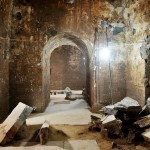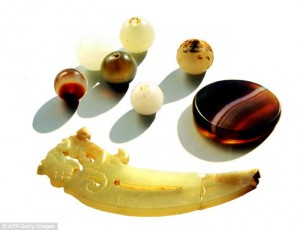 Chinese archaeologists have uncovered an 1800-year-old tomb in Xigaoxue, a village in Henan province in east central China, which they think belonged to legendary 3rd century warrior king Cao Cao.
Chinese archaeologists have uncovered an 1800-year-old tomb in Xigaoxue, a village in Henan province in east central China, which they think belonged to legendary 3rd century warrior king Cao Cao.
The mausoleum is large (8,000 square feet) and austerely decorated, which coincides with contemporary descriptions of Cao Cao’s burial. Inside the tomb archaeologists found the remains of one man in his 60s, — Cao Cao was said to be 66 when he died — a woman in her 50s — Cao’s wife died 10 years after him in 230 A.D. and was buried in his tomb — and another woman in her early 20s, possibly the queen’s servant/companion.
 The tomb was actually found last year by kiln workers digging for mud to make bricks, but it wasn’t until authorities caught looters with stone tablets inscribed “King Wu of Wei” – Cao’s posthumous title — stolen from the mausoleum that they began the official excavation.
The tomb was actually found last year by kiln workers digging for mud to make bricks, but it wasn’t until authorities caught looters with stone tablets inscribed “King Wu of Wei” – Cao’s posthumous title — stolen from the mausoleum that they began the official excavation.
Now that authorities know what a major find this could be, the tombs being carefully monitored to keep it safe from looters. Cao Cao is a looming figure in Chinese history and culture.
During his rise to power during the waning years of the Han Dynasty, Cao Cao became known as a clever yet cruel tyrant who was also a military genius.
His exploits form an important aspect of the 14th century historical novel “Romance of the Three Kingdoms,” known as one of China’s greatest literary works and a publication that remains widely read today.
Cao Cao remains a mainstay in Chinese culture and is a frequent character in Peking opera and historical theatre. He was most recently portrayed in director John Woo’s blockbusters “Red Cliff” and “Red Cliff 2”.
Cao Cao’s poetry is still taught in school, and his cruel cunning has elevated him from king to cultural reference. In Chinese, the expression “speak of the devil” translates to “speak of Cao Cao and Cao Cao arrives.”
 Over the past year of excavations, 250 artifacts have been found in the tomb complex, including stone carvings of daily life in Cao’s time, stone tablets bearing inscriptions of sacrificial objects, and some agate decorative items that could be Cao’s personal belongings.
Over the past year of excavations, 250 artifacts have been found in the tomb complex, including stone carvings of daily life in Cao’s time, stone tablets bearing inscriptions of sacrificial objects, and some agate decorative items that could be Cao’s personal belongings.
Chinese officials seem certain that the tomb is Cao Cao’s, but there is some debate in the scholarly community. The stone tablets are the best evidence that it’s Cao’s mausoleum, but since they weren’t found in context (thank you, looters), we can’t be sure that’s where they came from.
The looters are barbarians. :no:
Have you heard about the sevso treasure? :facepalm:
I have. It’s a travesty that it’s locked in a vault because the Marquess of Northampton foundation knows full well the treasure was looted and doesn’t want to address the controversy.
wow very good info :yes:
Thank you.